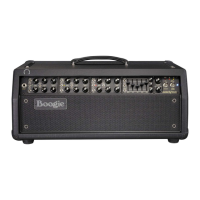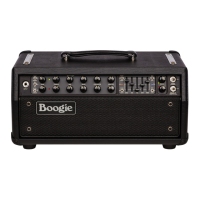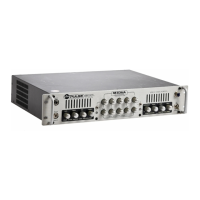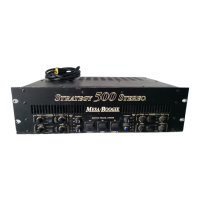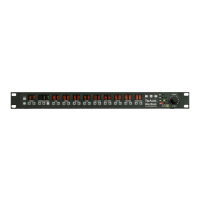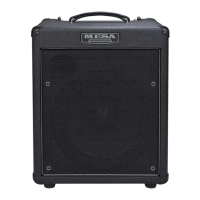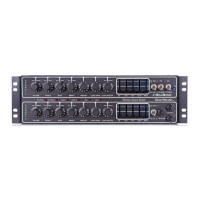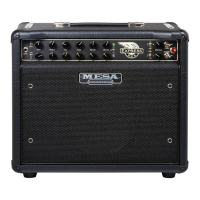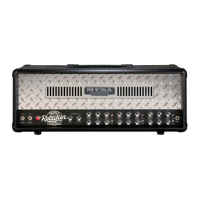PAGE 22
The “V Curve” also works for enhancing clean sounds, but it is usually preferred with a less exaggerated form
of the “V” pattern for sounds with less tube saturation. This would be especially true for the two lowest bands in
combination with the FAT Clean Mode in Channels 1 and 2, as this Mode has increased low end in its makeup.
For Crunch Rhythm sounds – whether in the CRUNCH or MK VII Modes or Channel 3’s IIC+ and IV Modes, the
added wideness and low-end “Chug” and top-end “grind” and high harmonics spread in the classic “V Curve”
allows for 4x12-like performance out of cabinets much smaller and with fewer speakers. It can even help open-
back Combos sound giant and menacing! The “V Curve” applied to our cascading gain is a signature sound
etched in rock for so many recording artists from the 70s when we first introduced it, through the 80s and 90s
when high gain ruled the airwaves, and on through today – as one of the biggest, widest guitar sounds ever
captured.
NOTE: EQ Hangover! Going abruptly back to a sound that is “flatter” and devoid of the mid dip/scoop, added low end and
boosted upper harmonics this classic “V” setting creates will sound flat, even “broken,” until your ears readjust to the
“normal” midrange content the amplifier has when not scooped out with the Graphic EQ.
This is an EQ Hangover and something we deal with all the time in R&D. It is no cause for alarm, but it can be unnerving the
first couple times you experience it.
When this happens, and it will if you explore the Graphic EQ like we hope you will, simply give your ears some time, perhaps
even stop playing for a few minutes or longer and come back after a period of “recovery” time, and your perspective will
return to a more balanced one.
ENGAGING THE 5BAND EQ
Controlling the EQ is done in each Channel individually in two ways, with the middle 2-position mini toggle in
the stack of three on the left side of the Channel.
You can choose 1) ON in the Channel or 2) O/Footswitchable in the Channel when the MARK VII Footswitch
is connected.
It can also be triggered with MIDI Program Change Messages. See the section in this Manual on MIDI control.
Should you ever need more finite control over the sound, you can always insert an EQ – a Graphic style with
more bands or a Parametric–style with overlapping sweepable frequencies for even more finite control over
the sound into the EFFECTS LOOP. We highly doubt you will ever need to, though, as thousands of players
worldwide over the last 50 years have turned to our Five Band EQ for its flexibility, musical accuracy, and ease
of operation.
80 Hz focuses on the sub-low end and can provide sub-air and richness for clean sounds and low-end “chug”
for high gain chording or bass lines. It works well with open-back cabinets to add some of the character and
low end that closed-back cabinets bring to the mix, obviously not physically, but rather electronically. This
low end comes late in the signal path, so often, it is the place to look for extra low end that will stay tight and
focused, especially for the IIC+ and MARK IV high gain sounds in Channel 3. Remember that the 80 Hz slider
carries a lot of power and has the potential to damage speakers if they are not rated for the power the Mark
VII has on tap.
240 Hz handles the region from the higher low end through the low midrange, bringing in and out fullness and
richness for clean sounds and chesty thump for gain sounds. This band often plays a supportive role rather
than a dominant one and fills in the gaps, nooks, and crannies. By itself, the 240 Hz is not the most instantly
gratifying frequency range, but its role is important nonetheless in arriving at a balanced sound. Remember
there is also ample power in the 240 slider’s higher low end to do some damage to speakers not rated to
handle the 90-watt power section. While not as potentially damaging perhaps as the 80 Hz slider, it DOES
carry low-end and midrange frequencies that can be tough on drivers not designed to handle them at higher
power/volume levels.
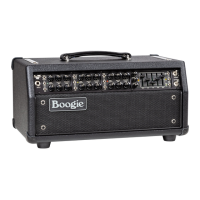
